The Inclusion of Karate
in the Public School System
Very few of us are blessed with the opportunity to do what we love

By Andy Allen
This article was published in the March 2018 issue (#135) of Shotokan Magazine
Without a doubt, the most rewarding part of my professional career as a high school teacher is to be blessed with the opportunity to teach what I love. I’m not talking about the various biology courses I have as part of my teaching assignment but rather a truly innovative high school course; Martial Arts 11. That’s right, I teach a credit course in martial arts, predominantly Shotokan karate.
In 2004, my principal at Charles P. Allen High School (CPA) in Bedford, Nova Scotia, Canada, approached me with an opportunity to offer the course. Naturally, as any karate enthusiast would, I jumped at the chance. How many people are fortunate enough do what they are passionate about in their profession?
In addition to regular karate training, Martial Arts 11 includes an academic component. I teach these sessions roughly once per week which cover topics such as Master Funakoshi’s dojo kun and niju kun, the benefits and consequences of habit formation, a bit of Japanese history (a brief study of the Heian period), yin yang/in yo, bushido, haiku poetry and conflict resolution.

A sample of artwork produced by Laura Nishida, former Martial arts 11 student. Laura’s work is a visual representation of in-yo/yin yang and bushido.
The first lesson I teach is an analysis of dojo kun. Students learn that the acquisition of physical skills is not the only goal of karate-do. Once they comprehend the message behind dojo kun they are asked to look inside themselves. To what extent do they already uphold these virtues, where do they fall short, and what can they change in their daily lives in the interest of improving their character?
Self-improvement is a theme we work on throughout the semester. In keeping with this theme, we partake in other exercises including studying Master Funakoshi’s Niji Kun 4, “Mazu jiko o shire, shikoshite ta o shire” (First Know Yourself, Then Know Others). After reading excerpts from Master Teruyuki Okazaki’s book, Perfection of Character, students learn that in order to make tangible improvements in their character they must first identify their flaws and then take action.
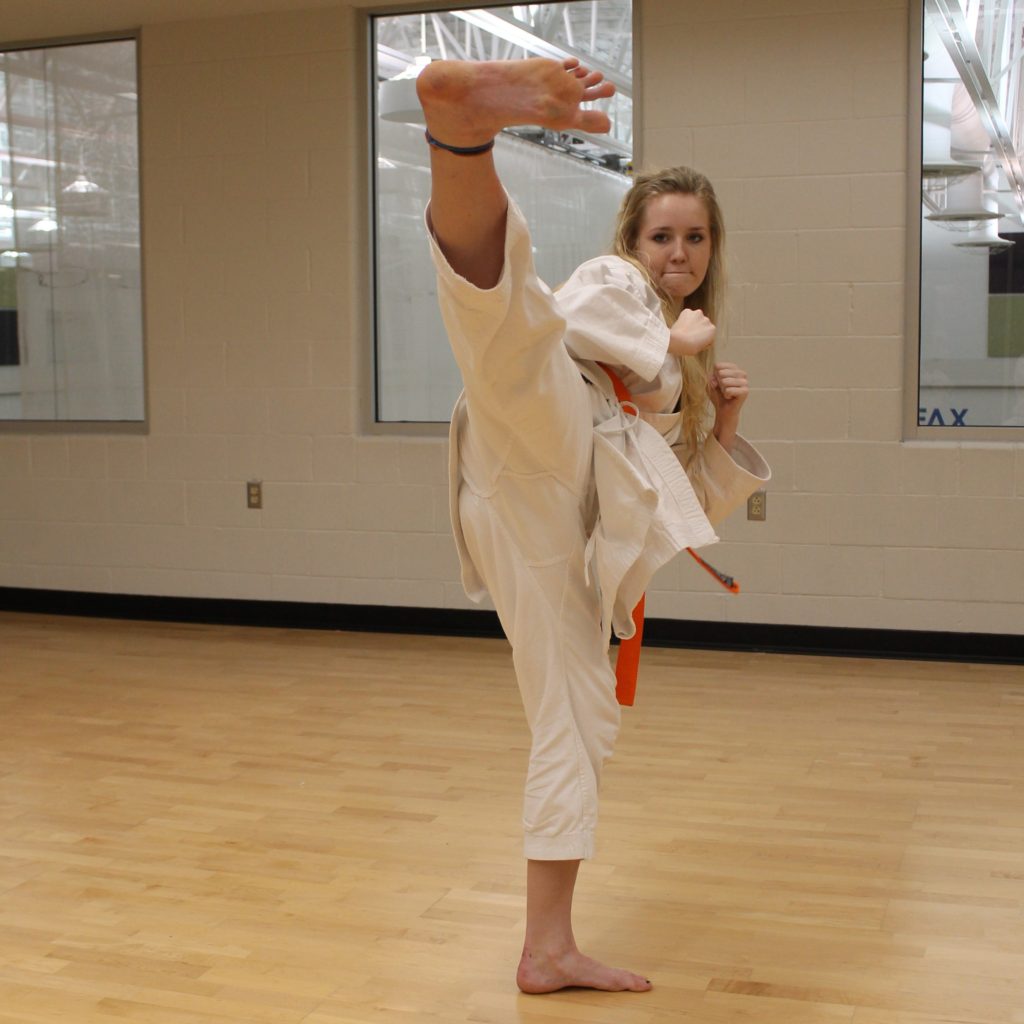
“…It’s not only the physical bit of it (karate) but also the mental piece that is very inspiring. We are taught to unite the mind and the body into one, to be a good person, to see things from different angles.”Yanna Tsedryk, 7th kyu.
Admittedly, asking 15 year olds to be introspective can be a tough sell. The budding philosophers in the class cautiously embrace it but others would prefer to train everyday. With one weekly classroom lesson, that leaves four days per week for students to practice their karate techniques. It is in the dojo (well actually, it’s the school gym) where it is most satisfying to facilitate students’ growth.
In the province of Nova Scotia, Canada, all high school students must have one physical education-based credit in order to graduate. Students at CPA can choose from mainstream Physical Education, Physically Active Living, Dance, Yoga, Fitness Leadership or Martial Arts. The general trend I have noticed at my school is that many of the natural athletes tend not to sign up for my course but instead opt for the mainstream physical education course. There are always exceptions but nonetheless that is the general trend every year. Many of the students who enrol in my course are not physical in their daily lives. They are often the kids that shy away from sports and spend a lot of time on their phones, gaming or are just stuck in a sedentary lifestyle at a shockingly early age. Some of these students have difficulty doing a single push up and have to be explicitly taught how to do a jumping jack. Others are surprised to discover that they have a natural aptitude for karate. For these individuals, tapping into their previously undiscovered talents is an exciting experience. Regardless of their level of athleticism, all students enjoy a steep learning curve.
Each period at my school is 75 min long which leaves a lot of time for skill development. Despite the fact that my class sizes are sometimes large (25 to 32 with no assistant), students progress quickly. The 15 year old brain is very plastic and spending five hours per week training results in a very steep learning curve.The progress they make in a five month semester is astounding. Sometimes, I videotape students doing basic kihon or kata and show the recording to them at the end of the semester. Through training, they gain the body awareness, coordination and balance.
Martial Arts 11 can make a difference in students’ lives
I have received a lot of positive feedback over early years from both students and parents. I remember a girl I taught a long time ago who had Asperger’s syndrome. As is part of the profile of those affected by this disorder, she had difficulty with social interactions, displayed idiosyncratic behaviours, and struggled with her spatial awareness and motor skills. Throughout the semester, this student stumbled through her kihon and struggled with the turns in her kata. Had I been asked what she thought of the course at the time, my assessment would be that she was less than thrilled to be in my class. To my surprise I couldn’t have been more wrong. At the end of the semester, the class was testing for their 8th kyu. I took them to the main dojo in Halifax, Nova Scotia where my sensei, Tony Tam conducted the grading. Afterwards, one of the female black belts from the Halifax dojo approached me. In the change room after the test, she had overheard my student tell a classmate, “The only reason I come to school is because of martial arts”. This student struggled to cope in high school, both socially and academically. Perhaps for her, karate training was a daily escape. She had to focus in her own development and was distracted from the struggles of trying to conform to social norms.
One of my most rewarding teaching moments involved a boy in my class a number of years ago. He was very quiet early in the semester but over the weeks he opened up and was soon my best student. He trained with tenacity and came to class hungry to learn. One day at the end of the semester, I received an emaiI from his mother thanking me for teaching her son. In her email, she explained that her son had been suffering from depression which I was unaware of. What struck a chord with me was that she wrote how happy she was that her son had finally started smiling again! As school teachers, coaches, karate instructors or anyone else that has worked with youth, there are surely many examples where we have had profound effects on young people’s lives to which we never become aware.

The author is shown with students discussing their performance after a kyu and dan grading. Mara So (foreground) started her training in the Martial Arts 11 course and had just passed her shodan exam at the time this photo was taken.
I have taught hundreds of students in my martial arts course over the years. Admittedly, not all students have shared my passion for karate but the apathetic students have been largely overshadowed by their classmates who are eager to learn.
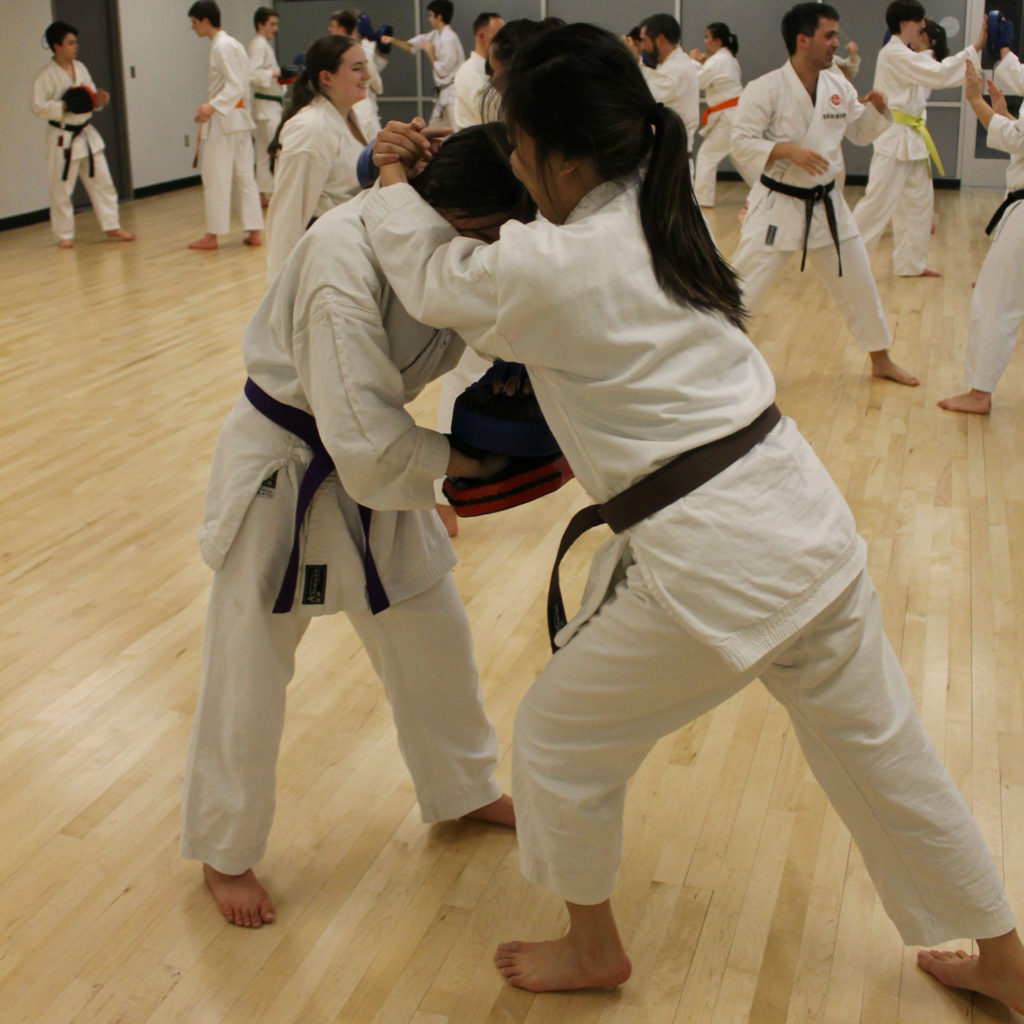
Patricia Borja, 3rd kyu, practicing a clinch and knee strike application from Heian Yondan. “It (Martial Arts 11) taught me about self-defence, mental focus, and stability. Once you start training, you gradually start to feel a physical and emotional change. When I felt that change, I told myself that this is something I want to keep experiencing.”
The Integration of Practical Karate in Martial Arts 11
In my early years of teaching Martial Arts 11, I used a 3K approach at which I have spent many years practicing. Any educator/coach/instructor will understand that there is a tendency to teach as we were taught, at least until one develops their own style and ideas. I consider this to be part of shu ha ri continuum in the assimilation of karate knowledge. Typical training in my course used to be limited to kihon, kata, kumite, a bit of pad work and some very basic self defense. I have a much different approach these days.
Despite all the positives I had experienced in my teaching, there came a time when I felt something was missing in my practice; something that had been bothering me for a long time. The missing component in my karate teaching and training was practicality.
Previously, my exposure to kata bunkai/oyo was limited to the JKA-inspired kata interpretations that dominates so many Shotokan organizations today; defence against traditional ‘karate attacks’, overly compliant opponents, attacks from impractical distances and ridiculous scenarios of multiple opponents attacking in turn. This ‘traditional’ bunkai, which dominates so many Shotokan organizations today, was what I occasionally taught in my class. Truthfully, I never enjoyed practicing or teaching it as I always felt it was impractical and awkward. The distancing was all wrong, the ‘karate’ style attacks were nonsensical and the aggressors had to attack ‘properly’ (read ‘impractical’) in order for the bunkai to work. Additionally, I just couldn’t buy into the idea that the purpose of kata was to defend against multiple opponents. It always felt like an implausible scenario from a Bruce Lee movie where the bad guys were polite enough to avoid attacking out of turn so as not to overwhelm the practitioner. Nonetheless, that is what I taught as it was all I knew about bunkai.
Unless you’ve had your head in the sand for past number of years, the practical karate movement has been steadily gaining momentum. I see this as more than just a fad: more like an awakening among many karate practitioners to the reality that modern karate has serious limitations and is far removed from its original purpose. Many practical karate advocates have an interest in revitalizing the old-school karate ways as an alternative or at least a supplement to the 3K approach of practicing karate.
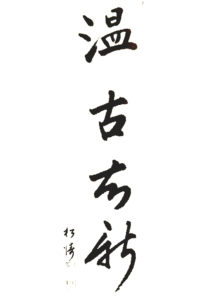
On Ko Chi Shin: “To study the old is to understand the new”. Brushed by Shuto (Funakoshi Gichin). Printed with permission from Patrick McCarthy.
About seven years ago, I stumbled across an Iain Abernethy YouTube video and was immediately intrigued. After much analysis, experimentation and research, kata finally started to make sense. Buried in kata are gritty applications for joint locks, limb clearing, chokes, throws and of course, strikes. After some trial and error, I began including Iain Abernethy’s principles of kata application into my teaching. Initial response from my students was encouraging.
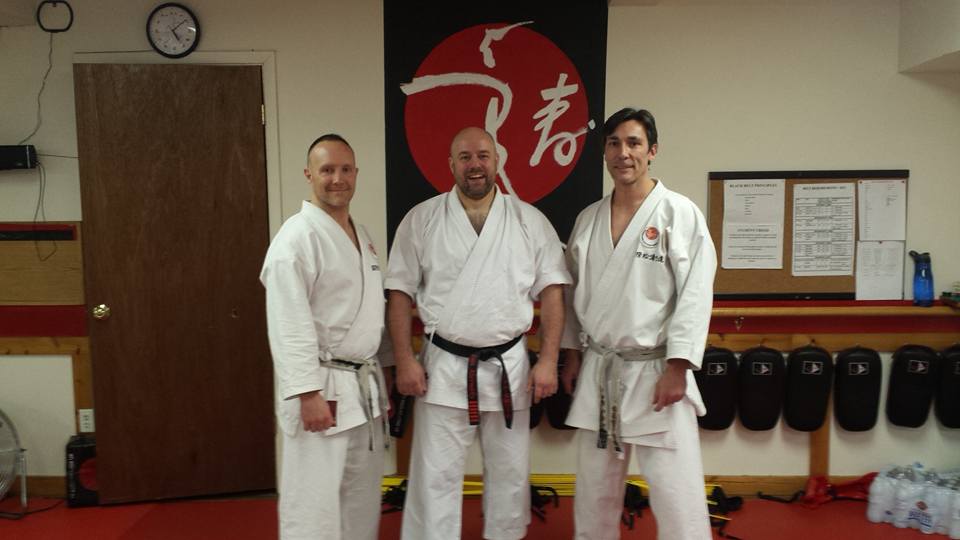
Iain Abernethy flanked by Jake Crawford (left) and the author (right) at his seminar in New Jersey. April 2016.
Over time, I became more and more comfortable with the practical approach to kata bunkai. I watched online videos and practiced with my less than enthusiastic wife in our living room. Eventually, I started to explicitly teach bunkai principles to my students; the purpose of angles in kata, the role of hikite (pulling hand), the concept of ‘backup plans’ in kata, there are no ‘blocks’ in karate, kata is for defence against Habitual Acts of Physical Violence (HAPV) as well as other important principles.
At the beginning of my journey into practical karate, I realized that my repertoire of grappling skills was sadly deficient as this is a skill set that is typically ignored in traditional Shotokan organizations. I began to seek out experiences that would give me the skills I needed for my own development and for that of my students.
I am grateful that on more than one occasion, my school board has provided funds to allow me to attend two Iain Abernethy seminars. This has afforded me the opportunity to develop my skills and understanding of kata bunkai and thus strengthen my program. I can honestly say that, as a teacher, this has been the best professional development I have ever attended. I left with practical skills that I used upon my return to school which improved students’ learning and helped them appreciate the beauty of kata as a sort of encyclopedia in motion rather than just kinesthetic poetry. Function over form.

The author practicing a shoulder lock at a Koryu Uchinadi seminar.
I have attended a number of local seminars taught by various experts in their fields including a Japanese Jujitsu black belt and a UFC fighter. Each experience has been helpful in deepening my understanding of the nature of close quarters combat, something not inherent in typical Shotokan practice. In particular, I had a lot of ‘ah-ha’ moments at the Japanese Jujitsu seminar. I watched demonstrations of drills and thought, “Hey, that’s Heian Sandan or , “That looks like Bassai Dai”. All these experiences have been beneficial for my personal development which in turn has influenced my teaching in Martial Arts 11.
Aside from these few seminars, lots of reading and watching a gargantuan amount of YouTube videos, I would consider myself to be largely self taught in the area of practical karate in the sense that I don’t explicitly train under a qualified instructor. The journey of self-instruction isn’t quick nor is it efficient but my practice has evolved into what I now consider to be firmly rooted in practical karate. When teaching kata bunkai at my high school, I no longer see eyes glaze over when demonstrating the meaning of the opening movements of Heian Shodan. There is nothing impressive or logical to blocking a mae geri and then countering with oi zuki as your partner conveniently steps back to make space for your long range counter attack. Even more preposterous is using the turn in movement three of Heian Shodan to defend against someone attacking from behind. Using the same opening sequence of Heian Shodan to off-balance, punch, grab and throw makes sense. My 15 year old beginner karate-ka love the physicality of kata oyo as it was meant to be.
Patrick McCarthy wrote that by going outside your art you are really going deeper inside it. Keeping this in mind, I found a local judo club at which I trained for about six months. My motivation for attending was to better understand throwing techniques in kata. The senseis were very helpful in helping me understand some of Funakoshi`s nine throws found in his text, Karate-Do Kyohan. Practicing throwing techniques is exhilarating but I soon discovered that despite my decent ukime, my middle aged body was not doing well with the constant slamming. I had started rather late in life. My judo sensei understood when I told him I could no longer continue and offered, `Judo is a young man`s game`.
Patrick McCarthy wrote that by going outside your art you are really going deeper inside it. Keeping this in mind, I found a local judo club at which I trained for about six months. My motivation for attending was to better understand throwing techniques in kata. The senseis were very helpful in helping me understand some of Funakoshi`s nine throws found in his text, Karate-Do Kyohan. Practicing throwing techniques is exhilarating but I soon discovered that despite my decent ukime, my middle aged body was not doing well with the constant slamming. I had started rather late in life. My judo sensei understood when I told him I could no longer continue and offered, `Judo is a young man`s game`.
Final Exam in Martial Arts 11
The final exam in Martial Arts 11 is a group project. Working in groups of three or four, students are tasked with the chore of creating an original kata which is quite an undertaking and requires several weeks of work. Essentially, students are required to develop numerous self defence techniques for various attacks and design a kata that incorporates the applications. Throughout the semester, principles of (good) bunkai are introduced including;
- Good kata bunkai teaches us to defend against Habitual Acts of Physical Violence (no `karate attacks`).
- Every movement in kata is meaningful (even movements often regarded as symbolic of nature have an application).
- Both hands have a purpose (the hikite and even chambering hands can have a function).
- Kata combinations can include ‘backup plans’ to follow failed attacks.
- Blocks (uke waza) are not necessarily blocks.
- Angles in kata represent where you want your attacker to be, not where they are attacking from.
- Kata is not designed for multiple attackers.
- Large movements in footwork can be used as throws/takedowns or they may simply be ‘linking’ movements.
- Think of kata movements as something you do to your opponent, not as a reaction to what your opponent does to you.
- The timing and rhythm of a kata does not represent how techniques are to be applied
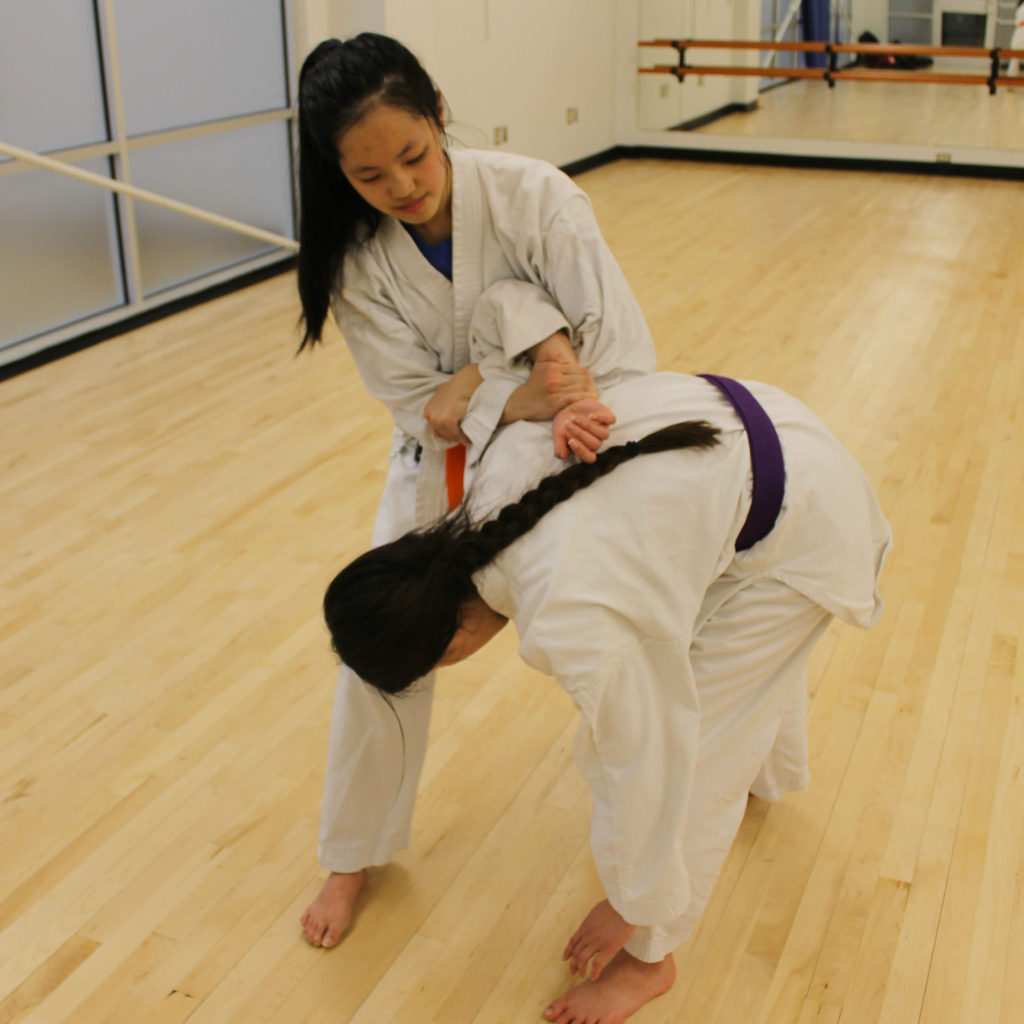
Tia Mousseau, 7th kyu, practices an uke waza application from Heian Sandan. “The course… showed me how there could be a time when I’ll need to defend myself and the things I learned from the course will definitely help me then. I decided to continue my training for not only the friends I made, for the physical exercise, for the benefits of learning self-defence, but I genuinely had a lot of fun practicing bunkai and kata…I found it fun to put techniques and kata into practice on real people.”
A thorough discussion of these ‘principles of bunkai’ would warrant a separate article on its own. In class, I discuss, model and give opportunities to practice these principles throughout the five month semester. By the time students start working on their exam, they are familiar with these concepts. Throughout the semester and leading up to exam time, I teach Heian Shodan, Heian Nidan and parts of many other katas including Heian Sandan through Godan, Tekki, Bassai Dai, Seinchin and others. Students are given numerous opportunities to practice applications from these katas.
The students’ kata creations must adhere to the following criteria.
- demonstrate defense against at least two different grabs (wrist, lapel, from behind etc)
- demonstrate defense against at least two punches (not a karate-style punch).
- include at least two throws or take-downs.
- use at least two kicks/knee strikes in the kata. (These should not be high kicks).
- use the principles of bunkai (angles, back-up plans etc).
- include at least two joint locks (wrists, elbows, shoulder).

Soomin Ahn, 7th kyu, (right), practices defense against a lapel grab. “My experience in the grade 11 martial arts class was amazing…running through techniques was fun and something I wanted to continue.”
Understandably, many students initially struggle with getting their kata creations started. To facilitate the process, I ‘chunk’ the criteria. Before I even discuss the exam, I will assign one of the criteria. For example, students are instructed to come up with a short two-person drill that demonstrates how to deal with a ‘haymaker’ punch. The students’ scenarios tend to start the same, with some sort of block. From there, some students follow with a trap and strike while others incorporate a takedown and submission. The next step is to determine what the kata should look like. Many students will use basic uke waza they have previously learned to represent their combative applications while others get more creative and make up original movements. I will then assign another criterion and students will go through the same process. Over time, each group will have developed a number of short two-person drills. The solo forms of these drills are eventually linked together to make their kata.
Life after Martial Arts 11
For years, students would tell me at the end of their semester that they would like to continue their karate training. Unfortunately, the nearest dojo is 20 minutes away. My high school students are too young to drive and the public transportation where I live is less than stellar. Almost every student who tried to continue their training and attempted to make the journey to Halifax eventually found the commute unmanageable. Many would train for a few months or a year only to eventually give it up.
Jake Crawford, long time friend of mine, also teaches Martial Arts 11 at Lockview High School in Fall River, Nova Scotia. In spring of 2016, he sent me a text, “Let’s start a club!”. I had been thinking of doing so for quite a while but never took the plunge. Having a dojo would allow my students to continue training. In September of that year the club opened under a non-profit model with nearly 20 students, many of whom were former Martial Arts 11 students. I currently have 24 registered students, 16 of which are former Martial Arts 11 students. It is incredibly rewarding to help lead young people along a new path in their lives.
This is my 14th year teaching karate in the public school system. When people hear I am a high school teacher they will invariably ask me, “What do you teach?”. I’ll rhyme off my assigned science courses for the current year ending with “…and martial arts”. The response is always the same, usually accompanied with raised eyebrows, “Wow, they never had that when I was in school!”

Gabby Jones, 2nd kyu, (left) practices a kata application from Heian Shodan. “I remember seeing Mr. Allen showing us Heian Shodan on the first day of training and thinking that was never going to be me. But now Kata is one of my favourite aspects of Karate…it became one of those things that I do just for myself.”
The Martial Arts 11 course is such a wonderful opportunity for young people allowing them to grow in so many facets of their development. Those who are open to the process gain body awareness, introspection, physical fitness and practical self defense skills. I am truly blessed with the chance to share my passion and vision with young people on a daily basis.
The students illustrated in this article are all former Martial Arts 11 students and have continued their training at the author’s dojo.